
Ancient Indian Fighting Techniques That Shaped the World of Martial Arts!
Rooted in ancient philosophies, spiritual practices, and survival strategies, these martial arts have been passed down through millennia, blending discipline, artistry, and combat expertise. These techniques not only reflect India's rich history but also its profound understanding of the human body, mind, and spirit.
INDIAN HISTORYEDUCATION/KNOWLEDGEINDIA/BHARATA LEARNING
Sachin K Chaurasiya
1/10/20256 min read


India, a land of diverse cultures and traditions, is also home to some of the world’s oldest and most sophisticated fighting techniques. Rooted in ancient philosophies, spiritual practices, and survival strategies, these martial arts have been passed down through millennia, blending discipline, artistry, and combat expertise. These techniques not only reflect India's rich history but also its profound understanding of the human body, mind, and spirit.
The Historical Context of Indian Martial Arts!
The origins of Indian fighting techniques can be traced back over 3000 years to the Vedic period. Ancient texts like the Vedas (वेद) and the Mahabharata (महाभारत) provide glimpses into the use of weaponry and hand-to-hand combat. The concept of warfare was deeply intertwined with dharma (धर्म) (righteousness), and warriors, or Kshatriyas (क्षत्रिय), were trained not just in physical combat but also in mental and spiritual fortitude.
Martial arts in India evolved as a holistic discipline, emphasizing the balance between strength and wisdom. These techniques were developed not just for self-defense but also as a means of achieving self-mastery and spiritual enlightenment.
Prominent Ancient Indian Fighting Techniques!
Kalaripayattu: The Mother of Martial Arts?
Believed to be one of the oldest martial arts in the world, Kalaripayattu (कलारिपयाट्टू) originated in Kerala around 3000 years ago. Its techniques are deeply influenced by ancient Indian philosophies (दर्शन), yoga (योग), and Ayurveda (आयुर्वेद).
Key Features
Movements: Kalaripayattu incorporates fluid and animal-inspired movements such as the lion, snake, and peacock. These movements ensure flexibility, agility, and strength.
Weaponry: Practitioners are trained in using a variety of weapons, including swords, spears, and daggers, along with unarmed combat techniques.
Healing Practices: Ayurveda (आयुर्वेद) and marmashastra (मर्मशास्त्र) (the study of vital points in the body) are integral to Kalaripayattu, making it a comprehensive system of combat and healing.
Cultural Impact: Kalaripayattu has influenced traditional dance forms and rituals in Kerala, showcasing the art’s cultural significance beyond combat.
Influence on Global Martial Arts: Scholars believe that Kalaripayattu played a foundational role in influencing East Asian martial arts like kung fu.

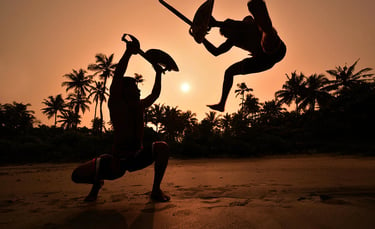
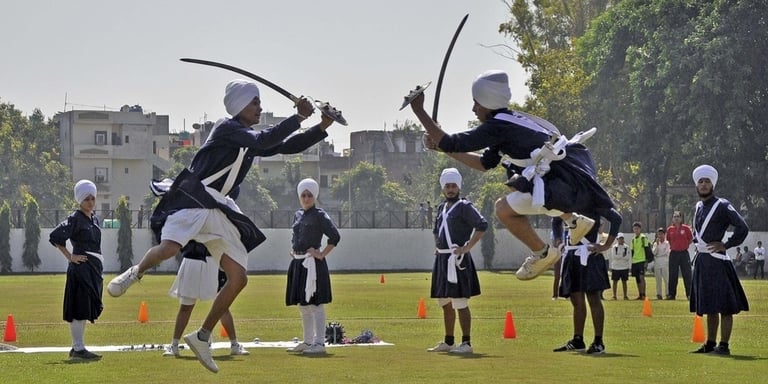

Gatka: The Sikh Warrior Art
Gatka (गटका/ਗੱਤਕਾ), rooted in Sikh (ਸਿੱਖ/सिख) traditions, originated in Punjab and was popularized during the time of the Sikh Gurus. It emphasizes the use of swords, sticks, and shields in combat.
Key Features
Spirituality: Gatka is not just a physical practice but a spiritual one, aligning with Sikh principles of bravery and righteousness.
Weapons: The primary focus is on weapon-based combat, including swords (kirpans) and shields.
Rhythm and Precision: Movements are choreographed to the beat of a drum, reflecting discipline and coordination.
Training for All Ages: Gatka training is inclusive, with practitioners from all age groups and genders participating to preserve this art.
Historical Context: Gatka was extensively used by Sikh warriors in their defense against invaders, symbolizing their indomitable spirit.
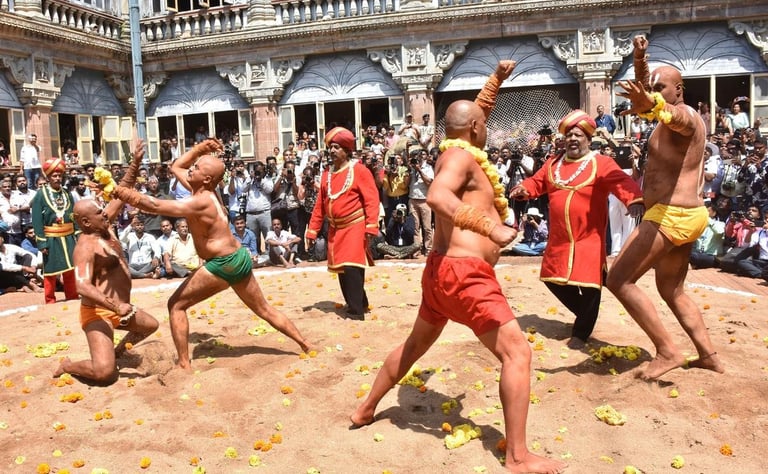

Vajra Mushti: The Thunder Fist
This ancient martial art, whose name translates to "Thunder Fist (वज्र मुष्टि)," originated in Gujarat and is mentioned in texts like the Mahabharata.
Key Features
Hand-to-Hand Combat: Vajra Mushti focuses on grappling, striking, and joint locks.
Weapons: The use of the knuckle duster-like weapon, called the Vajra, enhances the effectiveness of strikes.
Philosophy: It combines physical combat with meditative practices to enhance focus and inner strength.
Rarity: Vajra Mushti is a rare art form today, with only a few practitioners keeping its traditions alive.
Tournament Culture: Historical accounts describe competitive bouts of Vajra Mushti as part of royal entertainment and warrior training.
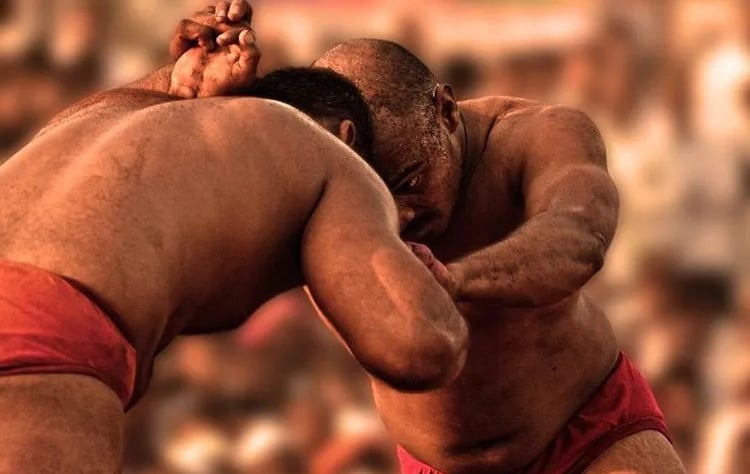

Malla-Yuddha: The Art of Wrestling
Malla-Yuddha (मल्लयुद्ध), or traditional Indian wrestling, is one of the oldest combat sports in the world. It finds mentions in ancient texts like the Ramayana and Mahabharata.
Key Features
Training Grounds: Wrestlers train in akharas (अखाड़ों) (mud pits), which symbolize a connection with nature.
Physical Fitness: Rigorous exercises, including lifting heavy stones and performing yoga, build endurance and strength.
Techniques: Holds, grapples, and locks are designed to overpower the opponent without causing severe injury.
Cultural Practices: Wrestling competitions, or dangals, are often tied to local festivals and community celebrations.
Legends: The epic battles of Bhima (भीम) and Duryodhana (दुर्योधन) in the Mahabharata highlight the significance of Malla-Yuddha.
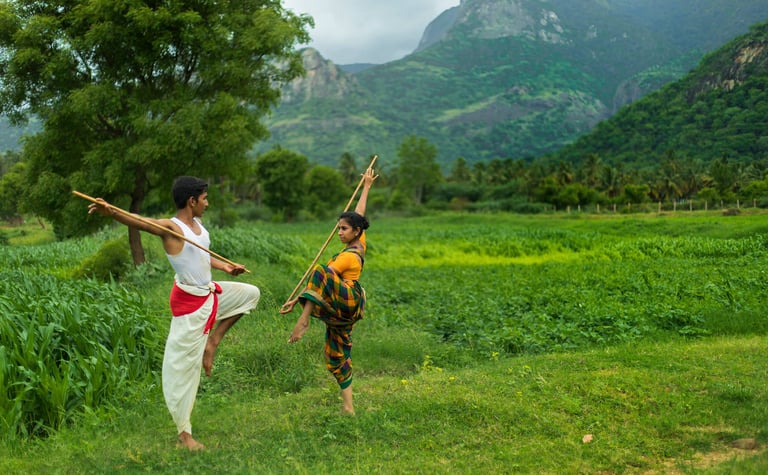

Silambam: The Staff-Wielding Art
Originating (मूल) in Tamil Nadu, Silambam (सिलंबम) focuses on the use of a bamboo (बांस) staff and is believed to date back to the Sangam period (संगम काल).
Key Features
Weaponry: Silambam practitioners are experts in handling the staff, swords, and knives.
Agility and Speed: The art emphasizes swift movements and precise strikes.
Cultural Connection: It is deeply embedded in Tamil folklore and traditions.
Modern Adaptations: Silambam is now practiced as a sport and has gained international recognition.
Military Applications: Historical records indicate its use in guerrilla warfare during colonial resistance movements.
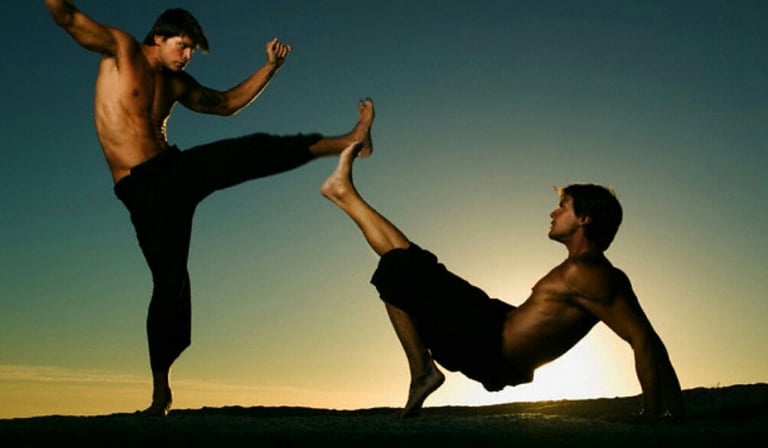

Musti-Yuddha: The Art of Bare-Handed Combat
Musti-Yuddha, an ancient unarmed combat style, focuses on punching techniques and is often associated with spiritual training.
Key Features
Techniques: It combines punches, kicks, and locks.
Spiritual Connection: Fighters often prayed to deities before combat, seeking blessings for victory and strength.
Legacy: It influenced many other martial art forms across the globe.
Decline: Although Musti-Yuddha has declined in popularity, efforts are underway to revive it.
Philosophical Roots: The art emphasizes control over aggression, reflecting its deep philosophical foundation.
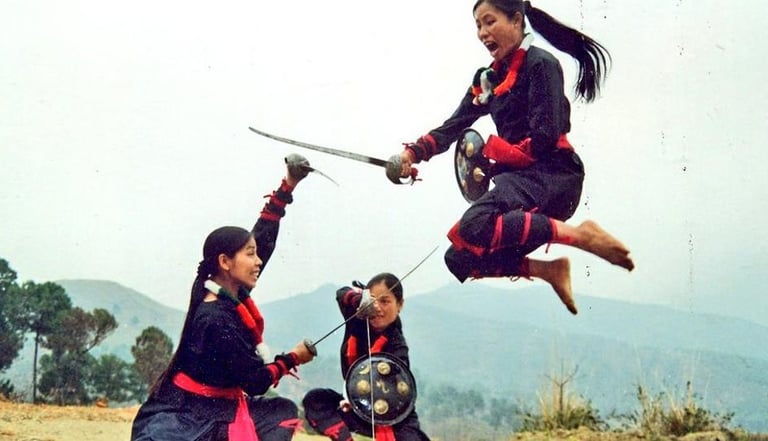

Thang-Ta: The Sword and Spear Art of Manipur!
Thang-Ta, originating from Manipur, is a traditional martial art focusing on sword (thang) and spear (ta) combat. It was historically used by Manipuri warriors in battles.
Key Features
Weaponry: Training includes the use of swords, spears, and shields.
Dance-Like Movements: Thang-Ta integrates rhythmic, dance-like motions that symbolize Manipuri culture.
Spiritual Practices: Many of its movements are inspired by ancient rituals and mythology.
Preservation Efforts: Thang-Ta is taught in cultural institutions to maintain its legacy.
Mythological Significance: Movements and techniques often draw inspiration from Manipuri folklore and legends.


Philosophical and Spiritual Dimensions!
What sets Indian fighting techniques apart is their integration of spiritual and philosophical elements. Ancient warriors were trained not just to fight but to embody virtues like humility, discipline, and compassion. The concept of shakti (inner energy) played a crucial role in martial training, with practices like yoga and meditation being an integral part of the regimen.
Additionally, the emphasis on marmashastra highlights the deep understanding of human anatomy. Practitioners were taught to target vital points to incapacitate opponents with minimal force, showcasing the scientific foundation of these techniques.
The Role of Women in Indian Martial Arts
Women have played a significant role in preserving and practicing these ancient fighting techniques. Historical accounts mention legendary female warriors like Rani Lakshmibai, who mastered sword fighting, and Nangeli of Kerala, who displayed extraordinary valor. Today, women actively participate in martial arts like Kalaripayattu and Silambam, breaking stereotypes and inspiring future generations.
Relevance in Modern Times
While the battlefield contexts have changed, these ancient fighting techniques continue to thrive in various forms. They have influenced global martial arts, including karate and kung fu, and are practiced for self-defense, fitness, and spiritual growth. Schools and akharas across India preserve these traditions, ensuring their legacy endures.
Moreover, these arts are gaining recognition internationally, with enthusiasts traveling to India to learn Kalaripayattu, Silambam, and other disciplines. Films, documentaries, and cultural exchanges have further highlighted the significance of Indian martial arts.
In addition, many modern self-defense systems incorporate elements from these ancient techniques, blending tradition with contemporary needs. They also contribute to preserving cultural identity and pride, particularly in younger generations.
The 3000-year-old Indian fighting techniques are more than just methods of combat; they are a testament to India’s rich cultural and spiritual heritage. They reflect a unique blend of physical prowess, intellectual depth, and spiritual enlightenment. As the world continues to explore these ancient arts, they serve as a reminder of the timeless wisdom and resilience embedded in India’s history.
Subscribe To Our Newsletter
All © Copyright reserved by Accessible-Learning Hub
| Terms & Conditions
Knowledge is power. Learn with Us. 📚


